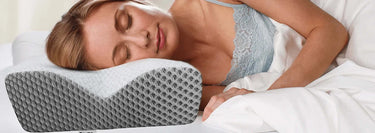Balanced leg elevation is pure mechanics. The wedge shape, angles, and foam structure decide where your weight goes, how far your legs travel, and whether your posture settles into a stable position or fights against the surface every time you elevate.
This page walks through the physics behind the Zen Bloks® Rest Ease™ leg elevation wedge. It explains how the center of mass, contact area, slope, and foam density combine to keep your legs supported in a repeatable, alignment-friendly position.
Table of Contents
- Center of Mass and Why It Drives Stability
- Contact Geometry: How Your Legs Touch the Wedge
- Load Paths, Angles, and Support Behavior
- Symmetrical vs Asymmetrical Elevation
- Foam Structure and Long-Term Consistency
- Practical Setup Guidelines for Stable Elevation
- Questions & Answers
1. Center of Mass and Why It Drives Leg Elevation Stability
Your legs are not a rigid stick. The thigh, knee, and lower leg each carry a different portion of your weight. The combined effect is a center of mass that usually sits closer to the upper leg than the ankle. A good elevation wedge is designed so that the center of mass settles in a controlled zone instead of drifting toward the front or rolling off the back.
On the Zen Bloks leg elevation angle page, we break down why the 30° incline is used. Page 5 takes that a step deeper. Here the focus is on where that mass ends up once your legs are resting and how the wedge keeps it there.
Neutral Stability Zone of Weight Distribution on Foam Wedge

(Above) This diagram shows how the leg’s center of mass aligns with the knee curve and upper platform of the wedge. When the center of mass sits directly above the smooth knee curve, the load distributes along the entire support line rather than collapsing into one area. The green-to-yellow gradient illustrates how the wedge manages pressure across the ramp and platform, keeping the leg stable and preventing drift or uneven settling during rest.
The vertical dashed line marks the wedge’s support line, which is engineered to stay aligned under the body’s natural load path. This alignment is what keeps elevation consistent and predictable, allowing the leg to rest without shifting or rolling into a steeper angle.
High Pressure Zones: Why You Want High Quality High Density Foam to Hold Leg Weight In Position for Long Periods of Time

(Above) This diagram shows how pressure naturally distributes across the wedge when weight is applied. The color gradient maps the load pattern:
-
Red = High-pressure zones
Concentration peaks at the knee curve and apex, where the leg’s center of mass transfers most of its load. -
Orange = Moderate pressure zones
The load spreads forward and downward as the foam begins to absorb and redirect force. -
Blue = Low-pressure zones
These areas carry minimal load and act as the stabilizing base that keeps the wedge seated against the floor.
The arrows show the direction of force dispersion, illustrating how a properly engineered wedge routes pressure outward along the entire structure rather than collapsing inward. This is exactly why density and geometry matter: the wedge maintains consistent elevation because the load is channeled through controlled paths rather than sinking into a single point.
On the Rest Ease™ wedge, the neutral stability zone sits across the knee curve and the forward part of the upper platform. When your legs are positioned correctly, the center of mass projects down into this zone, not into the tip of the wedge or the back edge.
- If the center of mass is too far forward, the legs tend to drift down the ramp, increasing lower leg strain and reducing elevation height.
- If the center of mass is too far back, the wedge feels unstable, and the thighs can roll off the apex region.
- When it is centered: your legs settle into a repeatable, balanced position with reduced tension through the hips and lower back.
The geometry of the knee curve is what makes that centering feel natural rather than forced. The curve is deliberately smooth, so your legs follow a shallow arc into a stable resting point rather than dropping into a sharp pocket.
2. Contact Leg Elevation Geometry: How Your Legs Touch the Wedge
Contact geometry is the pattern of surfaces that actually touch your body. This matters more than the marketing label on the foam. It controls how pressure spreads, where tension builds up, and whether your legs rest along a clean line or twist across the wedge.
Symmetrical vs Asymmetrical Load Image

(Above) This diagram shows how a leg wedge responds when weight is applied evenly versus unevenly. In Panel A, the load is symmetrical: the downward force is centered, the foam compresses predictably, and the wedge maintains its shape. This is the ideal scenario because it keeps your legs aligned and prevents the foam from twisting or breaking down over time.
In Panel B, the load is asymmetrical. The force comes in at an angle, creating uneven compression across the wedge. This is what happens when a wedge has poor geometry or the knee platform is too small or too steep. The foam ends up carrying more stress on one side, the user slides or rotates, and the wedge loses its support structure faster.
This image reinforces the main point of Page 5: balanced elevation isn’t just about comfort—it's about keeping the load centered so the foam can perform consistently and last longer.
Zen Bloks® splits the top profile into three primary contact zones, which you already saw diagrammed on earlier pages:
- Initial ramp: supports the lower leg and ankle, creating a predictable starting angle.
- Knee curve: receives the highest localized load as the leg bends.
- Upper platform: stabilizes the thigh and anchors the position.
If any of those zones are too soft, too short, or cut at the wrong angle, the contact pattern changes. The knee region can sink, the upper platform can feel vague, and the lower leg can lose support. The result is more strain and frequent micro-adjustments as your body searches for a stable line.
Why the Knee Curve Is the Control Point
The knee curve is the mechanical hinge between your lower leg and thigh. It carries peak pressure during elevation. If it collapses or flattens, your whole alignment changes. On the Rest Ease™ wedge, the curve and the density beneath it are tuned so that:
- The knee sinks slightly, enough for comfort, but
- the curve does not collapse into a deep pocket that traps your legs.
This balance is what keeps your body from sliding or rotating. You feel supported without feeling locked into an awkward groove.

(Above) How does it happen if soft, low-density, cheaper foam is used? Immediate loss of support and wedge breakdown. Soft, low-density foam collapses at the knee apex, concentrating pressure rather than spreading it across the wedge. When the high-pressure zone sinks, the knee curve flattens, and the entire elevation angle loses integrity. This leads to sliding, inconsistent support, and poor alignment. High-density ergonomic foam prevents this collapse and maintains the intended geometry, so the wedge performs the same every time you use it.
3. Leg Elevation Wedge Load Paths, Angles, and Support Behavior
Every part of your body that rests on the wedge sends force into the foam. The direction of that force is the load path. For elevation, the important thing is how much of that force runs straight down into the wedge and how much runs along the slope.
If the incline is too steep, more of the force points down toward the apex and less along the surface. That concentrates pressure into a small region. If the incline is too shallow, the legs may feel supported, but the elevation height drops, and alignment benefits fade.
(Above) This Diagram Shows Why High-Density Foam Matters For Support and Posture Alignment
Panel A (Even Force Distribution):
This is what happens on a well-designed wedge like Zen Bloks. The foam density and the curve geometry work together so your weight spreads outward across the entire surface. That even load keeps the shape consistent, supports your legs without hotspots, and helps you stay comfortably aligned for long periods.
Panel B (Force Concentration):
This is what happens with softer or poorly shaped wedges. Instead of spreading out, all your weight collapses into one point. That “force concentration” creates a dip right under the knee. The wedge loses its ergonomic angle, you start sliding, and the foam breaks down far faster over time.
Decomposing the Load
From a physics perspective, the load on the slope can be broken into two components:
- Standard component: force pressing straight into the wedge surface.
- Tangential component: force running along the surface, trying to slide the legs down the ramp.
The 30° incline used on the Zen Bloks® wedge is a deliberate compromise. It is steep enough to elevate the legs for posture support and daily recovery, but shallow enough that the tangential component does not dominate and pull your legs forward.
High-density foam at the apex and knee curve makes that standard component more predictable. The surface compresses in a controlled way instead of folding, which keeps the line of support stable from session to session.
Why Load Paths Matter for Comfort
You do not think about force decomposition while resting, but your body notices instability. If the load path constantly shifts, your muscles stay partially active to correct drift. When the wedge shape manages the load correctly, those micro-corrections fade, and the legs can settle. That is the practical effect of getting the physics right.
4. Symmetrical vs Asymmetrical Leg Elevation
The wedge itself is symmetrical. Your body is not always. One hip may sit slightly higher, one leg may rotate outward, or one ankle may drop. When both legs are placed on the wedge but carry weight differently, the center of mass shifts off the midline.
Small asymmetries are normal. The problem is when the setup exaggerates them. If one leg rests higher up the ramp than the other, or if only one thigh is fully supported on the upper platform, the load becomes uneven. That creates a twist through the pelvis and lower back, increasing tension rather than reducing it.
How to Use the Wedge Symmetrically
- Align the midpoint of the wedge with the center of your body, not with a single leg.
- Place both heels or calves at similar positions along the ramp.
- Check that both knees reach the curve rather than one knee sitting on the ramp and the other on the platform.
- If one hip tends to rotate outward, bring that leg slightly in toward the midline.
The wedge is designed to reward symmetry. When both legs share the same elevation path, the foam compresses more evenly, the angle feels cleaner, and the overall posture becomes easier to maintain during a rest session, reading, or wind-down routine.
5. Leg Wedge Foam Structure and Long-Term Consistency
Geometry alone is not enough. The foam has to hold that geometry under repeated use. On the foam density and response behavior page, you saw how cell structure affects rebound. Here, the focus is on long-term compression and what it does to elevation physics.
Low-density foam starts in the right shape, then slowly loses height in the highest-stress zones. First the apex softens, then the knee curve flattens. The angle you thought you bought is not the angle you get a year later.
Zen Bloks® uses ergonomic-grade density to resist that permanent set. The foam remains elastic within the expected load range, preventing the wedge from developing a permanent dip in the curve or platform. As a result:
- The elevation angle stays consistent,
- The center of mass lands in the same neutral zone each time, and
- the contact pattern along the ramp, curve, and platform stays predictable.
Visualizing Micro-Level Behavior
At the micro level, the open-cell network inside the foam behaves like a lattice. In the elastic phase, cell walls bend and rebound fully. At fatigue onset, low-quality foams start to crack at junctions. Wall failure appears when repeated cycles push the material beyond its structural limit. The diagrams on the material behavior page illustrate this breakdown.
By selecting higher density and compression-resistant foam, Zen Bloks® keeps the lattice operating in the elastic phase under regular use. That is what allows the wedge to feel firm, supportive, and familiar over the long term instead of slowly collapsing.
6. Practical Setup Guidelines for Stable Leg Elevation
All of this physics only matters if the wedge is used in a way that takes advantage of the design. A few small adjustments can dramatically improve how stable and supportive the setup feels.
Step 1: Position the Wedge
- Place the wedge so the long ramp faces away from your torso.
- Align the midline of the wedge with your body’s center, not with a single leg.
- Use a flat, stable surface. A soft mattress will change the effective angle.
Step 2: Place the Legs
- Rest the lower legs along the ramp so the calves feel fully supported.
- Allow the knees to settle naturally into the knee curve without forcing extra bend.
- Check that the thighs are resting on the upper platform rather than hanging off the edge.
Step 3: Fine-Tune Alignment
- Look at both knees. They should be at a similar height and angle.
- Adjust foot position so both legs follow the same path along the ramp.
- If you feel one side carrying more tension, slightly reposition that leg closer to the center of the wedge.
These steps may seem small, but they align your body with the engineered support pattern within the wedge. Good physics plus good setup is where the real comfort lives.
Questions & Answers
Does a firmer leg wedge always mean better support?
Not automatically. The goal is controlled firmness that keeps angles and alignment consistent without feeling harsh. Zen Bloks® uses firm, ergonomic foam where structure matters and contouring where contact comfort matters, especially at the knee curve.
Why does leg elevation angle accuracy matter so much?
Angle accuracy determines how your weight splits between the ramp, curve, and platform. If the angle drifts over time because foam collapses, the load paths change, and the wedge no longer supports your intended posture.
How is this different from stacking pillows under your knees?
Pillows shift, compress unevenly, and do not provide a defined structural angle. A dedicated wedge has a fixed geometry, a tuned density, and a predictable load path, giving you repeatable support instead of a new setup every night.
Is this leg wedge meant for short breaks or longer rest periods?
Both. The physics and foam structure are designed for stable elevation during short resets, evening wind-down routines, or longer relaxation sessions where you want your posture to stay consistent.
Next topics you may find useful:
Ergonomic Design Principles Behind Zen Bloks®
Foam Density and Response Behavior
Compliance note: Zen Bloks® products are ergonomic comfort products, not medical devices. They are designed to support posture, alignment, and everyday comfort and are not intended to diagnose, treat, or cure any condition.






